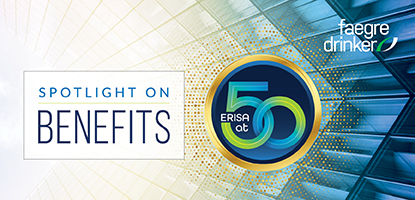On December 18, 2020, the Department of Labor (“DOL”) adopted PTE 2020-02 Improving Investment Advice for Workers & Retirees (“PTE 2020-02”), a new prohibited transaction exemption related to fiduciary investment advice offered to plan sponsors and plan participants of ERISA-governed retirement plans and IRA owners.
Last month, the DOL issued guidance in the form of FAQs to address questions concerning the practical application of PTE 2020-02 (“FAQs”). These FAQs discuss various applications of PTE 2020-02, including guidance with respect to the general requirements of PTE 2020-02, recommendations for the rollover of employee benefit plan assets to an IRA, the use of disclaimers, the requirement to mitigate conflicts of interest, the use of payout grids for compensation, and the application of PTE 2020-02 to insurance industry financial institutions.
This blog post summarizes the DOL’s guidance with respect to the general requirements of PTE 2020-02. In two upcoming blog posts, we will discuss more specific aspects of the FAQs.
Requirements of PTE 2020-02
PTE 2020-02 is intended, the DOL states, to “promote investment advice that is in the best interest of retirement investors” in a way that is more broad and more flexible than previous prohibited transaction exemptions, and that incorporates a “best interest” standard for providing investment advice to retirement plan investors. Accordingly, PTE 2020-02 requires financial institutions and investment professionals relying on the exemption to:
- Provide advice in accordance with the Impartial Conduct Standards:
- Give advice in the best interest of the retirement investor in accordance with the fiduciary duties of prudence and loyalty;
- Charge no more than reasonable compensation; and
- Make no misleading statements.
The DOL notes that the best interest standard does not prevent financial institutions and investment professionals from receiving compensation for their advice; rather, it is to ensure that they do not place their own interests (financial or otherwise) ahead of the interests of the retirement investor and is intended to work with a wide variety of payment structures. The FAQs also provide guidance on the structure and implementation of payout grids, used by some financial institutions to calculate investment professional compensation.
- Acknowledge in writing their and their investment professionals’ fiduciary status.
The DOL notes the intent of this requirement is to establish the clear fiduciary relationship between the retirement plan investor and the financial advisor under ERISA and/or the Internal Revenue Code. The DOL provides model language for investment professionals to use in complying with this condition of PTE 2020-02.
- Describe in writing the services to be provided and the financial institutions’ and investment professionals’ material conflicts of interest.
The DOL indicates that this disclosure cannot be a “check the box” type of activity. Rather, the financial institution and the investment professional must “undertake a careful analysis” to identify any material conflicts of interest and the disclosure of material conflicts of interest should be clear enough and include enough “meaningful information” that a “reasonable person could assess both the scope and severity” of the conflict of interest.
- Document the reasons that a rollover recommendation is in the best interest of the retirement investor and provide that documentation to the retirement investor.
The DOL states that the labor regulations defining fiduciary investment advice extend to rollover recommendations and the FAQs address several topics specifically related to rollover recommendations. We will discuss the DOL’s guidance related to rollover recommendations in a future blog post.
- Adopt policies and procedures prudently designed to ensure compliance with the Impartial Conduct Standards and to mitigate any possible conflicts of interest.
The DOL states that it reviews a financial institution’s conflict mitigation policies and procedures as a whole, including the mitigation of conflicts of both the investment professional and the financial institution as a whole. There is NO safe harbor based solely on compliance with other regulators’ standards (such as those imposed by the SEC).
- Conduct an annual retrospective compliance review.
The DOL indicates that this process must be reasonably designed to detect and prevent violations of the Impartial Conduct Standards. The financial institution must produce a written report that is certified by one of the financial institution’s senior executive officers. The financial institution must retain the report and its certification for six years and provide these documents to the DOL within 10 business days of a request.
Contact your Faegre Drinker attorney to discuss the application of the PTE 2020-02 to your particular circumstance.
The material contained in this communication is informational, general in nature and does not constitute legal advice. The material contained in this communication should not be relied upon or used without consulting a lawyer to consider your specific circumstances. This communication was published on the date specified and may not include any changes in the topics, laws, rules or regulations covered. Receipt of this communication does not establish an attorney-client relationship. In some jurisdictions, this communication may be considered attorney advertising.

